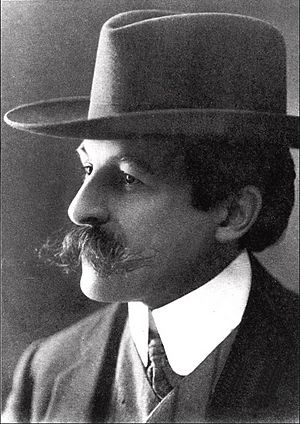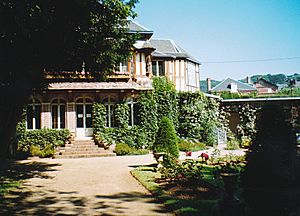Maurice Leblanc facts for kids
Quick facts for kids
Maurice Leblanc
|
|
|---|---|

Leblanc in 1907
|
|
| Born | Marie Émile Maurice Leblanc 11 December 1864 Rouen, France |
| Died | 6 November 1941 (aged 76) Perpignan, France |
| Resting place |
|
| Occupation | Writer |
| Education | Lycée Corneille (1875-1882) |
| Genre | Detective fiction, science fiction, psychological novel |
| Years active | 1890-1941 |
| Notable works | Arsène Lupin |
| Spouses |
|
| Children | Louise Amélie Marie Leblanc (1889-1974) |
| Relatives | Georgette Leblanc |
| Signature | |
Maurice Marie Émile Leblanc (born December 11, 1864 – died November 6, 1941) was a famous French writer. He is best known for creating the character Arsène Lupin. Lupin is a clever gentleman thief and detective. Many people see him as the French version of Arthur Conan Doyle's Sherlock Holmes.
The first story about Arsène Lupin appeared in a magazine called Je sais tout. It was published on July 15, 1905. The stories became very popular very quickly. Leblanc soon started writing full-length novels about Lupin. He spent most of his writing career on these exciting adventures.
Leblanc also wrote some interesting science fiction novels. One was Les Trois Yeux (1919). In this book, a scientist talks to three-eyed beings from Venus. Another was Le Formidable Evènement (1920). This story describes an earthquake that creates new land between England and France.
Maurice Leblanc received the Légion d'Honneur for his contributions to literature. This is a very important award in France. He passed away in Perpignan in 1941. His sister, Georgette Leblanc, was also a well-known artist.
Contents
Life of Maurice Leblanc
Maurice Leblanc was born in Rouen, France. He was the second child in his family. His father was a ship-owner, and his mother came from a wealthy family. When he was young, his family sent him to Scotland during the Franco-German War of 1870.
After the war, he returned to France to finish his schooling. He studied at the Lycée Corneille from 1875 to 1882. As a teenager, he often met famous writers like Gustave Flaubert and Guy de Maupassant.
Starting His Writing Career
Maurice's father wanted him to work in a card factory. But Maurice chose to move to Paris in 1888 to become a writer. He started as a journalist and then became a novelist. His first novel, "Une femme" (A Woman), was published in 1893. It was quite successful. He wrote other books too, like "Des couples" and "Voici des ailes."
In 1902, he wrote a play called "La pitié." It was not very successful, so he stopped writing for the theater for a while. In 1901, he published "L'Enthousiasme," which was a story about his own life.
The Birth of Arsène Lupin
In 1905, a magazine director named Pierre Lafitte asked Leblanc to write a short story. He wanted a character similar to A.J Raffles and Sherlock Holmes. This led to the creation of "L'Arrestation d’Arsène Lupin" (The Arrest of Arsène Lupin). People loved the story right away.
Two years later, the book Arsène Lupin, Gentleman Burglar was released. It collected the first nine Lupin stories. Another book, Arsène Lupin versus Herlock Sholmes, followed. This book made Arthur Conan Doyle, the creator of Sherlock Holmes, quite upset. He felt that Leblanc's characters, Herlock Sholmes and Wilson, were making fun of his own work.
Later Years and Legacy
Maurice Leblanc received the Legion of Honor in 1908. This was a recognition of his important work in literature. Over time, Leblanc grew tired of writing about Arsène Lupin. He even tried to end his hero's story in the novel "813" in 1910. However, he brought Lupin back to life in the story The Crystal Stopper.
In 1918, Maurice Leblanc bought a special house in Étretat. He named it Clos Lupin. He wrote many of his novels and short stories there. When World War II was about to begin, he left Clos Lupin in 1939. He moved to Perpignan, where he died in 1941 from pneumonia. He was later reburied in the Montparnasse cemetery in Paris.
Maurice Leblanc's Family Life
Maurice Leblanc moved to Paris in 1888. He married Marie-Ernestine Flannel in 1889. They had a daughter named Louise Amélie Marie Leblanc. Later, Maurice married Marguerite Wormser in 1906. Marguerite had a son from a previous marriage, who later took the name Leblanc.
Lasting Impact
Maurice Leblanc's work had a big impact on other writers. It inspired authors like Gaston Leroux, who created Rouletabille. It also influenced Souvestre and Allain, who created Fantômas.
The adventures of Arsène Lupin often took place in Paris and in a region called Pays de Caux. Maurice Leblanc knew this area very well. He even collected postcards of many old houses there. Fans of Arsène Lupin, sometimes called "lupinophiles," enjoy visiting the real places mentioned in Leblanc's stories. These places include Étretat, Tancarville, and the underground passage of Jumièges.
See also
 In Spanish: Maurice Leblanc para niños
In Spanish: Maurice Leblanc para niños
- Marius Jacob


